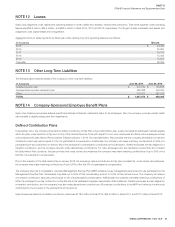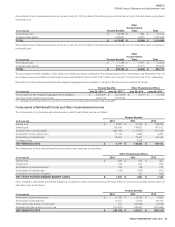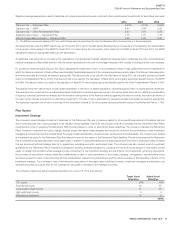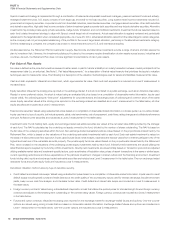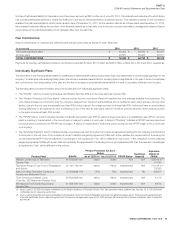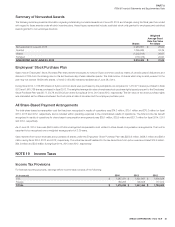Sysco 2014 Annual Report Download - page 84
Download and view the complete annual report
Please find page 84 of the 2014 Sysco annual report below. You can navigate through the pages in the report by either clicking on the pages listed below, or by using the keyword search tool below to find specific information within the annual report.SYSCO CORPORATION-Form10-K72
PARTII
ITEM8Financial Statements and Supplementary Data
Sysco’s investment strategy is implemented through a combination of balanced and specialist investment managers, passive investment funds and actively-
managed investment funds. U.S. equity consists of both large-cap and small-to-mid-cap securities. Long duration xed income investments include U.S.
government and agency securities, corporate bonds from diversi ed industries, asset-backed securities, mortgage-backed securities, other debt securities
and derivative securities. High yield xed income consists of below investment grade corporate debt securities and may include derivative securities. Alternative
investments may include private equity, private real estate, hedge funds, timberland, and commodities investments. Investment funds are selected based on
each fund’s stated investment strategy to align with Sysco’s overall target mix of investments. Actual asset allocation is regularly reviewed and periodically
rebalanced to the target allocation when considered appropriate. As of June 28, 2014, actual asset allocation varied from the stated target in certain categories,
as the company had not yet completed rebalancing of the portfolio to the current target asset allocation, particularly in the alternative investments category.
Until the rebalancing is complete, the company has chosen to invest these amounts in U.S. and international equities.
As discussed above, the Retirement Plan’s investments in equity, xed income and alternative investments provide a range of returns and also expose the
plan to investment risk. However, the investment policies put in place by the company require diversi cation of plan assets across issuers, industries and
countries. As such, the Retirement Plan does not have signi cant concentrations of risk in plan assets.
Fair Value of Plan Assets
Fair value is de ned as the price that would be received to sell an asset or paid to transfer a liability in an orderly transaction between market participants at the
measurement date (i.e. an exit price). See Note 5, “Fair Value Measurements,” for a description of the fair value hierarchy that prioritizes the inputs to valuation
techniques used to measure fair value. The following is a description of the valuation methodologies used for assets and liabilities measured at fair value.
Cash and cash equivalents: Valued at amortized cost, which approximates fair value. Cash and cash equivalents is included as a Level 2 measurement in
the table below.
Equity securities: Valued at the closing price reported on the exchange market. If a stock is not listed on a public exchange, such as an American Depository
Receipt or some preferred stocks, the stock is valued using an evaluated bid price based on a compilation of observable market information. Inputs used
include yields, the underlying security “best price”, adjustments for corporate actions and exchange prices of underlying and common stock of the same
issuer. Equity securities valued at the closing price reported on the exchange market are classi ed as a Level 1 measurement in the table below; all other
equity securities are included as a Level 2 measurement.
Fixed income securities: Valued using evaluated bid prices based on a compilation of observable market information or a broker quote in a non-active market.
Inputs used vary by type of security, but include spreads, yields, rate benchmarks, rate of prepayment, cash ows, rating changes and collateral performance
and type. All xed income securities are included as a Level 2 measurement in the table below.
Investment funds: Funds holding debt, equity and exchange-traded real estate securities are valued at the net asset value (NAV) provided by the manager
of each fund. The NAV is calculated as the underlying net assets owned by the fund, divided by the number of shares outstanding. The NAV is based on
the fair value of the underlying securities within the fund. Non-exchange traded real estate funds are valued based on the proportionate interest held by the
Retirement Plan, which is based on the valuations of the underlying real estate investments held by each fund. Each real estate investment is valued on
thebasis of a discounted cash ow approach. Inputs used include future rental receipts, expenses and residual values from a market participant view of the
highest and best use of the real estate as rental property. The private equity funds are valued based on the proportionate interest held by the Retirement
Plan, which is based on the valuations of the underlying private equity investments held by each fund. Indirectly-held investments are valued utilizing the
latest nancial reports supplied by the fund’s portfolio investments. Directly-held investments are valued initially based on transaction price and are adjusted
utilizing available market data and investment-speci c factors, such as estimates of liquidation value, prices of recent transactions in the same or similar issuer,
current operating performance and future expectations of the particular investment, changes in market outlook and the nancing environment. Investment
funds holding debt, equity and exchange traded real-estate securities are included as a Level 2 measurement in the table below. The non-exchange traded
real estate funds and private equity funds are included as Level 3 measurements.
Derivatives: Valuation method varies by type of derivative security.
•
Credit default and interest rate swaps: Valued using evaluated bid prices based on a compilation of observable market information. Inputs used for credit
default swaps include spread curves and trade data about the credit quality of the counterparty. Inputs used for interest rate swaps include benchmark
yields, swap curves, cash ow analysis, and interdealer broker rates. Credit default and interest rate swaps are included as a Level 2 measurement in
the table below.
•
Foreign currency contracts: Valued using a standardized interpolation model that utilizes the quoted prices for standard-length forward foreign currency
contracts and adjusts to the remaining term outstanding on the contract being valued. Foreign currency contracts are included as a Level 2 measurement
in the table below.
•
Futures and option contracts: Valued at the closing price reported on the exchange market for exchange-traded futures and options. Over-the-counter
options are valued using pricing models that are based on observable market information. Exchange-traded futures and options are included as a
Level1 measurement in the table below; over-the-counter options are included as a Level 2 measurement.







